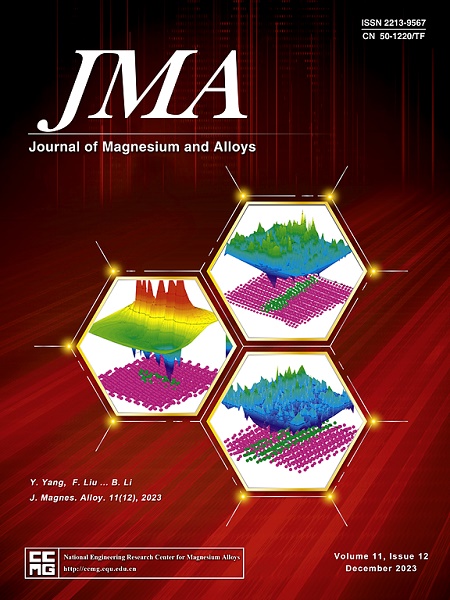基于人工神经网络和有限元分析相结合的镁合金内纵肋圆柱件热流成形微观组织演变研究
IF 15.8
1区 材料科学
Q1 METALLURGY & METALLURGICAL ENGINEERING
引用次数: 0
摘要
热流成形(HFF)是制造镁合金纵向内肋薄壁圆柱形零件(CPLIR)的一种很有前途的成形技术,在航空航天领域有着广泛的应用。然而,由于热机械耦合效应和刚性结构的存在,镁合金薄壁带纵向内肋的圆柱壁(CW)和内肋(IR)在加氢脱硫过程中容易出现复杂的微观结构演变和微观结构不均匀。本文采用人工神经网络(ANN)方法,建立了考虑变形条件对材料参数影响的镁合金改进单元自动机(CA)模型。研究发现,与传统 CA 模型相比,ANN 修正 CA 模型对热变形微观结构的预测能力更强。此外,通过将修正的 CA 模型与有限元分析(FEA)相结合,分析了 ZK61 合金 CPLIR 在热变形过程中的微观结构演变。结果表明,与 IR 层的微观组织相比,CW 层的微观组织由于应变和应变速率较大而导致晶粒更细化、DRX 更不充分;CW 层和 IR 层之间壁厚上的应变和应变速率存在各种差异,导致微观组织的不均匀性由内层向外层先上升后下降;CW 层和 IR 层的实测显微硬度与预测晶粒大小之间的 Hall-Petch 关系表明 FEA-CA 耦合模拟结果是可靠的。本文章由计算机程序翻译,如有差异,请以英文原文为准。
Study of microstructure evolution of magnesium alloy cylindrical part with longitudinal inner ribs during hot flow forming by coupling ANN-modified CA and FEA
Hot flow forming (HFF) is a promising forming technology to manufacture thin-walled cylindrical part with longitudinal inner ribs (CPLIRs) made of magnesium (Mg) alloys, which has wide applications in the aerospace field. However, due to the thermo-mechanical coupling effect and the existence of stiffened structure, complex microstructure evolution and uneven microstructure occur easily at the cylindrical wall (CW) and inner rib (IR) of Mg alloy thin-walled CPLIRs during the HFF. In this paper, a modified cellular automaton (CA) model of Mg alloy considering the effects of deformation conditions on material parameters was developed using the artificial neural network (ANN) method. It is found that the ANN-modified CA model exhibits better predictability for the microstructure of hot deformation than the conventional CA model. Furthermore, the microstructure evolution of ZK61 alloy CPLIRs during the HFF was analyzed by coupling the modified CA model and finite element analysis (FEA). The results show that compared with the microstructure at the same layer of the IR, more refined grains and less sufficient DRX resulted from larger strain and strain rate occur at that of the CW; various differences of strain and strain rate in the wall-thickness exist between the CW and IR, which leads to the inhomogeneity of microstructure rising firstly and declining from the inside layer to outside layer; the obtained Hall-Petch relationship between the measured microhardness and predicted grain sizes at the CW and the IR indicates the reliability of the coupled FEA-CA simulation results.
求助全文
通过发布文献求助,成功后即可免费获取论文全文。
去求助
来源期刊

Journal of Magnesium and Alloys
Engineering-Mechanics of Materials
CiteScore
20.20
自引率
14.80%
发文量
52
审稿时长
59 days
期刊介绍:
The Journal of Magnesium and Alloys serves as a global platform for both theoretical and experimental studies in magnesium science and engineering. It welcomes submissions investigating various scientific and engineering factors impacting the metallurgy, processing, microstructure, properties, and applications of magnesium and alloys. The journal covers all aspects of magnesium and alloy research, including raw materials, alloy casting, extrusion and deformation, corrosion and surface treatment, joining and machining, simulation and modeling, microstructure evolution and mechanical properties, new alloy development, magnesium-based composites, bio-materials and energy materials, applications, and recycling.
 求助内容:
求助内容: 应助结果提醒方式:
应助结果提醒方式:


